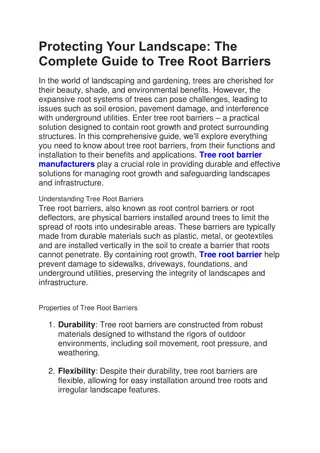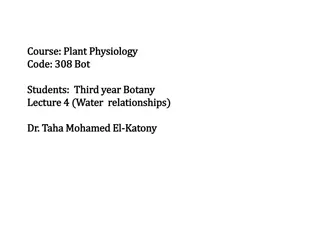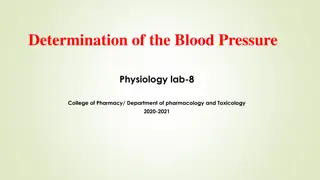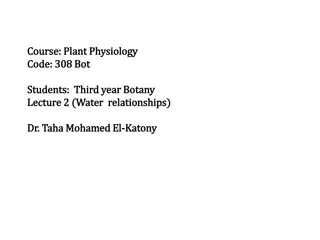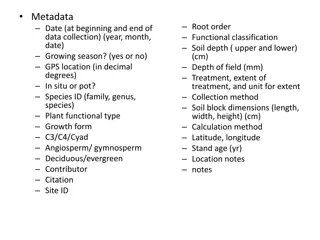Understanding Root Pressure in Plant Physiology
Root pressure is the pressure developing in xylem vessels due to metabolic activities of the roots. It is an active process driven by osmotic mechanisms and the absorption of salts by the roots. This pressure plays a key role in translocation of water, affecting factors like respiration, exudation rates, and water absorption in plants. The diurnal fluctuation of exudation rates is linked to salt transfer into the xylem, showcasing the close relationship between root pressure and water dynamics within plants.
Download Presentation

Please find below an Image/Link to download the presentation.
The content on the website is provided AS IS for your information and personal use only. It may not be sold, licensed, or shared on other websites without obtaining consent from the author. Download presentation by click this link. If you encounter any issues during the download, it is possible that the publisher has removed the file from their server.
E N D
Presentation Transcript
Course: Plant Physiology Course: Plant Physiology Code: Code: 308 308 Bot Bot Students: Third year Botany Students: Third year Botany Lecture Lecture 3 3 (Water relationships) (Water relationships) Dr. Dr. Taha Taha Mohamed El Mohamed El- -Katony Katony
Translocation of water Translocation of water Root pressure Root pressure The stump of a The stump of a detopped watery sap, w watery sap, which can build up i hich can build up if the stump is attached with a rubber sleeve to a glass tube attached with a rubber sleeve to a glass tube containing water. containing water. detopped herbaceous plant exudes herbaceous plant exudes f the stump is Root pressure is the pressure developing in xylem Root pressure is the pressure developing in xylem vessels as a result of the metabolic activities of the vessels as a result of the metabolic activities of the root. root. Root pressure is an active process; due to osmotic Root pressure is an active process; due to osmotic mechanisms, as a result of the active absorption of mechanisms, as a result of the active absorption of salts by the root. salts by the root.
Root pressure Root pressure is respiration (e.g. O respiration (e.g. O2 2 tension, narcotics, respiration inhibitors). respiration inhibitors). is affected by factors that affect affected by factors that affect tension, narcotics, auxin auxin and and The The exudations exudations caused by diurnal diurnal fluctuation fluctuation agreement between the agreement between the periodicity pressure and the exudation rate. pressure and the exudation rate. caused by root pressure root pressure exhibit and and there is a close there is a close periodicity of root exhibit of root Exudation rate Exudation rate is the speed of is the speed of release of the cut surface of the stem. the cut surface of the stem. release of liquid at liquid at
Exudation rate of detopped plants is proportional to the concentration of salt in the medium. The diurnal fluctuation of exudation rate is caused by a periodicity of salt transfer into the xylem. This causes a periodicity in s of the xylem ducts, which affects the rate of water absorption in accordance with a change in w gradients. Absorption of water does not require a direct expenditure of energy. Energy is expended in the absorption and accumulation of salts; but the w gradient is the driving force for water absorption.
Participation of root pressure Earlier opinion: Rise of water in plants is primarily the result of root pressure. But now, root pressure has a minor role in ascent of sap because: 1. It is of low magnitude, not sufficient to push water in most trees. Root pressure averages around 2 atm; occasionally may reach 6 atm and is absent in conifers which are among the tallest trees. In addition, the friction encountered in the passage of water through the xylem ducts should be considered.
2 2. . E Exudation rates are generally much slower than xudation rates are generally much slower than normal transpiration rates. normal transpiration rates. Xylem sap is usually under tension instead of Xylem sap is usually under tension instead of pressure. pressure. Nevertheless, when transpiration is low, root pressure Nevertheless, when transpiration is low, root pressure may be a significant factor in the ascent of sap. may be a significant factor in the ascent of sap. In some plants, liquid water loss, (guttation), caused In some plants, liquid water loss, (guttation), caused by root pressure, is observed under conditions by root pressure, is observed under conditions unfavorable for transpiration. unfavorable for transpiration.
The vital theory The vital theory Early investigators believed that the ascent of water Early investigators believed that the ascent of water in plants is controlled by vital activities in the stem. in plants is controlled by vital activities in the stem. Evidence: Xylem tissue contains living cells (xylem Evidence: Xylem tissue contains living cells (xylem parenchyma and xylem ray cells). parenchyma and xylem ray cells). However, stems in which the living cells were However, stems in which the living cells were poisoned are still capable of water translocation. poisoned are still capable of water translocation.
The cohesion The cohesion- -tension theory tension theory In the figure: a long tube full In the figure: a long tube full of water is submerged by of water is submerged by one of its ends in water and one of its ends in water and a soaked sponge was put at a soaked sponge was put at the other end of the tube so the other end of the tube so as water is continuous in as water is continuous in the system. the system. Observation: Observation: column of water is pulling column of water is pulling up from the beaker. up from the beaker. an an unbroken unbroken
The The process process can can be be accelerated accelerated by by * a fan to move dry air over the sponge and by * a fan to move dry air over the sponge and by * heat to increase temperature of the air * heat to increase temperature of the air surrounding the sponge. surrounding the sponge. The rate of water ascent in the tube is directly related The rate of water ascent in the tube is directly related to its rate of evaporation from the sponge. to its rate of evaporation from the sponge. As water evaporates from the sponge it is replaced by As water evaporates from the sponge it is replaced by water from the tube, which in turn is replaced by water from the tube, which in turn is replaced by water from the beaker. water from the beaker.
Two questions: 1. How can a column of water be pulled up in the tube without break? 2. Why does not the column of water when under tension pull away from the wall of the tube? The answer is in the cohesive(1) and adhesive(2) properties of water. Water molecules (1) cohere to each other and (2) adhere to the wall of the tube. Therefore, the water column will not break (this can done by an interruption of the column by air.
This physical example is comparable to the plant. Water in the beaker is analogous to the soil water. The glass tube is analogous to the tracheary elements (xylem vessels) of the stem. The sponge is similar to the leaf mesophyll. As water evaporates from the leaf's mesophyll cells their w becomes more negative. Water lost is replaced by water moving from cell to cell within the mesophyll along the w gradient.
Finally the pull of water within the leaf will be transmitted to water in the xylem elements in the veins, hence putting water in the lumina of xylem vessels under tension. This tension is continuous through unbroken columns of water (due to the cohesive and adhesive properties of water) from the leaves to the root system. The w in living cells of root becomes more negative relative to the w of soil solution, thus promoting absorption.
Evidence in favor of the presence tension in xylem vessels. Evidence in favor of the presence tension in xylem vessels. 1. 1. A leafy shoot cut under water and sealed to a A leafy shoot cut under water and sealed to a manometer supports a column of mercury above manometer supports a column of mercury above barometric level. barometric level. 2. 2. If a twig of a transpiring plant is cut, water in the If a twig of a transpiring plant is cut, water in the xylem elements snaps away from the cut surface; xylem elements snaps away from the cut surface; this is the basis for the pressure bomb procedure this is the basis for the pressure bomb procedure used to determine used to determine w w. .
3.The 3.The Dendrograph Dendrograph measures measures diurnal diurnal variation variation diameter of tree diameter of tree trunks. trunks. in in
When water in the xylem When water in the xylem elements is under tension, it elements is under tension, it will, because of its adhesive will, because of its adhesive properties, cause a shrinkage properties, cause a shrinkage in the diameters of xylem in the diameters of xylem vessels. vessels. This decrease in diameter is This decrease in diameter is small in individual vessels, but small in individual vessels, but the total effect can be the total effect can be recorded by a dendrograph. recorded by a dendrograph.
This instrument gives a This instrument gives a continuous record of continuous record of changes in the changes in the diameter of a trunk diameter of a trunk over a period of time. over a period of time. Diameter decreases Diameter decreases during periods of during periods of high transpiration high transpiration (summer, day) and (summer, day) and increases in periods increases in periods of low transpiration of low transpiration (spring, night). (spring, night).
The question now is: Can the tensile strength of The question now is: Can the tensile strength of water support rise of water to the tops of the water support rise of water to the tops of the highest trees? highest trees? The tensile strength of water > The tensile strength of water > 300 300 bars. bars. Raising water to the top of Raising water to the top of 400 a difference in pressure of a difference in pressure of 12 top and bottom. top and bottom. 400 feet tree requires feet tree requires 12 bars between the bars between the In addition, water encounters considerable friction In addition, water encounters considerable friction as it moves through the xylem tissue. as it moves through the xylem tissue. The tensile strength of water is sufficient to The tensile strength of water is sufficient to overcome the frictional and gravitational forces overcome the frictional and gravitational forces encountered in its rise in the plant. encountered in its rise in the plant.
In conclusion: In conclusion: 1 1- - The cohesion The cohesion- -tension theory is the most plausible tension theory is the most plausible explanation of the translocation of water in a explanation of the translocation of water in a vigorously transpiring plant. vigorously transpiring plant. 2 2- - Root pressure can raise water, but not in the Root pressure can raise water, but not in the proper quantity and height. proper quantity and height. 3 3- - In general, any physiological event (water loss, In general, any physiological event (water loss, solute buildup or translocation, mineral solute buildup or translocation, mineral absorption) that causes more negative absorption) that causes more negative w water movement. water movement. w w (high (high w gradients between two points) will influence gradients between two points) will influence



